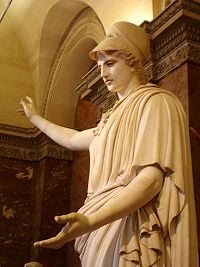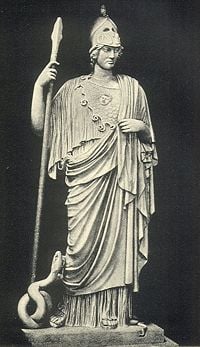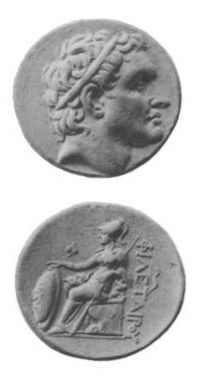Difference between revisions of "Athena" - New World Encyclopedia
Chris Jensen (talk | contribs) (New page: {{started}} right|thumb|200px|''Helmeted Athena'', of the [[Velletri type. Roman copy (1st century) of a Greek original by [[K...) |
({{Contracted}}) |
||
| Line 1: | Line 1: | ||
| − | {{started}} | + | {{started}}{{Contracted}} |
[[Image:Athena type Velletri.jpg|right|thumb|200px|''Helmeted Athena'', of the [[Velletri]] type. Roman copy (1st century) of a [[Art in Ancient Greece|Greek]] original by [[Kresilas]], ''c.'' [[430s B.C.E.|430 B.C.E.]]]] | [[Image:Athena type Velletri.jpg|right|thumb|200px|''Helmeted Athena'', of the [[Velletri]] type. Roman copy (1st century) of a [[Art in Ancient Greece|Greek]] original by [[Kresilas]], ''c.'' [[430s B.C.E.|430 B.C.E.]]]] | ||
Revision as of 15:04, 18 April 2007
In Greek mythology, Athena (Greek: Άθηνά, Athēnâ, or Ἀθήνη, Athénē; Doric: Άσάνα, Asána; Latin: Minerva) was the goddess of civilization, specifically wisdom, weaving, crafts and the more disciplined side of war (violence and bloodlust were Ares' domain). Athena's wisdom encompasses the technical knowledge employed in weaving, metal-working, but also includes the cunning intelligence (metis) of such figures as Odysseus. The owl and the olive tree are sacred to her. Her name is derived from Greek Ἀθεονόα, Atheonóa (= from god's (theos) mind (nous)). Her nicknames were Άτρυτώνη, Atrytone (= the unwearying), Παρθένος, Parthénos (= virgin), and Ή Πρόμαχος, Promachos (the pre-fighter/-tress, i. e. the person who fights in front).
She is attended by an owl, and is often accompanied by the goddess of victory, Nike. Wearing a goatskin breastplate called the Aegis given to her by her father, Zeus,[1], she is often shown helmeted and with a shield bearing the Gorgon Medusa's head, a votive gift of Perseus. Athena is an armed warrior goddess, and appears in Greek mythology as a helper of many heroes, including Heracles, Jason, and Odysseus. She never had a consort or lover, and thus was often known as Athena Parthenos ("Athena the virgin"), hence her most famous temple, the Parthenon, on the Acropolis in Athens. However, she was the mother of Erichthonius by an attempted rape[citation needed], which failed. Athena, disgusted, wiped the seed with wool, which was sacred to Gaia, and so Erichthonius was conceived.
In her role as a protector of the city, Athena was worshiped throughout the Greek world as Athena Polias ("Athena of the city"). She had a special relationship with Athens, as is shown by the etymological connection of the names of the goddess and the city.[2] Athena is associated with Athens, a plural name because it was the place where she presided over her sisterhood, the Athenai, in earliest times.[3] Athena was probably already a goddess in the Aegean in prehistoric times.[4] There is evidence that in early times, Athena was an owl herself, or a bird goddess in general. In Book 3 of the Odyssey, she takes the form of a sea-eagle. Her tasseled aegis may be the remnants of wings:[5] she is depicted with wings on Archaic red-figure pottery. Template:Greek myth (Olympian)
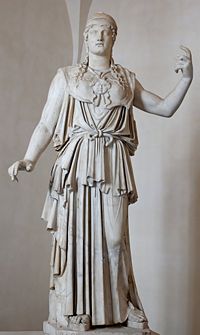
In the Olympian pantheon, Athena was remade as the favorite daughter of Zeus, born fully armed from his forehead after he swallowed her mother, Metis. The story of her birth comes in several versions. In the one most commonly cited, Zeus lay with Metis, the goddess of crafty thought and wisdom, but immediately feared the consequences. It had been prophesied that Metis would bear children more powerful than the sire,[6] even Zeus himself. In order to forestall these dire consequences, Zeus transformed Metis into a fly and swallowed her immediately after lying with her.[citation needed] He was too late: Metis had already conceived a child. Metis immediately began making a helmet and robe for her fetal daughter. The hammering as she made the helmet caused Zeus great pain and Prometheus, Hephaestus, Hermes or Palaemon (depending on the sources examined) cleaved Zeus's head with the double-headed Minoan axe (the labrys of the Great Goddess). Athena leaped from Zeus's head, fully grown and armed, and Zeus was none the worse for the experience.
Fragments attributed to the semi-legendary Phoenician historian Sanchuniathon, said to have written before the Trojan war, make Athena instead the daughter of Cronus, a king of Byblos who is said to have visited 'the inhabitable world' and bequeathed Attica to Athena.
Name, etymology and origin
Athena's name is possibly of Lydian origin.[7] It may be a compound word derived in part from Tyrrhenian "ati", meaning "mother" and the name of the Hurrian Goddess "Hannahannah" shortened in various places to "Ana". In Mycenaean Greek, she possibly appears in a single inscription in the Linear B tablets: A-ta-na-po-ti-ni-ja /Athana potniya/ appears on a text from the Late Minoan II-era "Room of the Chariot Tablets" in Knossos, the earliest Linear B archive anywhere.[8] Though this phrase is often translated as "Mistress Athena", it literally means "the potnia of At(h)ana", which perhaps means "the Lady of Athens";[9] it is uncertain whether there is any connection to the city of Athens.[10] We also find A-ta-no-dju-wa-ja /Athana diwya/, the final part being the Linear B spelling of what we know from ancient Greek as Diwia (Mycenaean di-u-ja or di-wi-ja) "divine" Athena was also a weaver and the god of crafts. (see dyeus).[11] The name Athens comes from Athena
In his dialogue Cratylus, Plato gives the etymology of Athena's name based on the view of the ancient Athenians,[12] from A-theo-noa (A-θεο-νόα) or E-theo-noa (H-θεο-νόα) meaning "the mind of God" (Cratylus 407b). Plato, and also Herodotus, noted that the Egyptian citizens of Sais in Egypt worshipped a goddess whose Egyptian name was Neith;[13] they identified her with Athena. (Timaeus 21e), (Histories 2:170-175).
Epithets and cult titles
In poetry from Homer onward, Athena's most common epithet is glaukopis (γλαυκώπις), which is usually translated "bright-eyed" or "with gleaming eyes".[14] It is a combination of glaukos (γλαύκος, meaning "gleaming," "silvery," and later, "bluish-green" or "gray") and ops (ώψ, "eye," or sometimes, "face"). It is interesting to note that glaux (γλαύξ, "owl") is from the same root, presumably because of its own distinctive eyes. The bird which sees in the night is closely associated with the goddess of wisdom: in archaic images, she is frequently depicted with an owl perched on her head. In earlier times, Athena may well have been a bird goddess, similar to the unknown goddess depicted with owls, wings and bird talons on the Burney relief, a Mesopotamian terracotta relief of the early second millennium B.C.E.
In the Iliad (4.514), the Homeric Hymns and in Hesiod's Theogony, she is given the curious epithet Tritogeneia. The meaning of this term is unclear. It seems to mean "Triton-born," perhaps indicating that the sea-god was her father according to some early myths,[15] or, less likely, that she was born near Lake Triton in Africa. Another possible meaning is "triple-born" or "third-born," which may refer to her status as the third daughter of Zeus or the fact she was born from Metis, Zeus and herself; various legends list her as being the first child after Artemis and Apollo, though other legends identify her as Zeus' first child.
In her role as judge at Orestes' trial on the murder of his mother, Clytemnestra (which he won), Athena won the epithet Athena Areia.
Pallas and Athena: Pallas Athena
She was often referred to as Pallas Athena (Ancient Greek Παλλάς Άθήνη, modern Greek Παλλάς Αθηνά). The epithet derived from an ambiguous figure named Pallas, sometimes male, sometimes female, mentioned apart from Athena only as a family of characters in Vergil's Aeneid. According to some sources, Pallas, the playmate of Athena, was a daughter of the god Triton (or Tritonis), Athena's foster-father. The goddess killed Pallas, in some versions by mistake. For instance, in a Pelasgian version of her birth myth Pallas was the playmate whom Athena killed by mistake in a game battle, Afterwards she addeed the name of Pallas to her own as a sign of mourning.[16] She also carved from a tree trunk a wooden cult image (xoanon) of Pallas, the Palladium, which she left with Zeus. Later Electra, whom Zeus seduced, took refuge behind this palladium; Zeus tossed it away and it fell upon the land of Ilium (Troy), where Ilus had a temple built for it.
In the Homeric Hymn to Hermes, Pallas was the father of the moon goddess Selene. In other versions Pallas was one of the Gigantes killed by her in the Gigantomachy; forever after she wore the goatskin fringed with chthonic serpents of Pallas, as the protective aegis[citation needed]. She may have absorbed and supplanted Pallas more gently: Walter Burkert says "she is the Pallas of Athens, Pallas Athenaie, just as Hera of Argos is Here Argeie.[17] For the Athenians, Burkert notes, she was simply "the Goddess", he theos, certainly an ancient title.
Other sources claim that Pallas was an older local god conflated with Athena by the Athenians.[18]
Other cult titles
Athena was given many other cult titles. She had the epithet Athena Ergane as the patron of craftsmen and artisans. With the epithet Athena Parthenos ("virgin"), Athena was worshiped on the Acropolis, especially in the festival of the Panathenaea. With the epithet Athena Promachos she led in battle. With the epithet Athena Polias ("of the city"), Athena was the protectress of Athens and its Acropolis, but also of many other cities, including Argos, Sparta, Gortyn, Lindos, and Larisa. She was given the epithet Athena Hippeia or Athena Hippia as the inventor of the chariot, and was worshipped under this title at Athens, Tegea and Olympia. As Athena Hippeia she was given an alternative parentage: Poseidon and Polyphe, daughter of Oceanus. [19][20]. In each of these cities her temple was frequently the major temple on the acropolis.[21]
Athena was often equated with Aphaea, a local goddess of the island of Aegina, located near Athens, once Aegina was under Athenian's power.
In classical art
Athena is classically portrayed wearing full armor, with the helmet raised high on the forehead like a hat; she carries a spear and a shield with the head of the gorgon Medusa mounted on it. It is in this standing posture that she was depicted in Phidias's famous lost gold and ivory statue of her, 36 feet tall, the Athena Parthenos in the Parthenon. Athena is also often depicted with an owl (a symbol of wisdom) sitting on one of her shoulders. The Mourning Athena is a relief sculpture that dates around 460 B.C.E. and portrays a tired, emotional Athena. In earlier, archaic portraits of Athena in Black-figure pottery, the goddess retains some of her Minoan character, such as great bird wings.
Apart from her attributes, there seems to be a relative consensus in sculpture from the fifth century onward as to what Athena looked like. Most noticeable in the face is perhaps a high nose with a high bridge that almost seems like a natural extension of the forehead. The eyes are typically somewhat deeply set. The lips are usually full but the mouth is fairly narrow, usually just slightly wider than the nose. The neck is somewhat longish. The net result is a serene, somewhat aloof beauty.
History
Birth
Hesiod's Theogony gives the following account of Athena's birth: Metis, the titaness of prudence, was Zeus' first wife. It was fated that if she had a son he would be able to rule the gods. Zeus, fearing that his son would overthrow him as Zeus had done to Cronus, tricked Metis and swallowed her. He ingested her and therefore her wisdom so that she might advise him in matters. However, the immortal child Metis was pregnant with was not harmed, and Athena was born from his head after he had married Hera. Hera was so annoyed at this that she gave birth to Hephaestus by herself. The son was never born and Zeus stayed as supreme ruler of Mount Olympus.
A fuller version says: Zeus lay with Metis, the goddess of crafty thought, but immediately feared the consequences. It had been prophesied that Metis would bear children more powerful than the father, and this includes even Zeus himself. In order to forestall these dire consequences, Zeus played a game with Metis. She transformed into many creatures, big and small. When Metis transformed into a fly, Zeus swallowed her immediately after lying with her. He was too late: Metis was already pregnant. Metis immediately began making a helmet and robe for her fetal daughter. The hammering as she made the helmet caused Zeus great pain and Hephaestus cut open Zeus's skull with the double-headed Minoan axe (labrys). Athena leaped from Zeus's skull, fully grown and armed, and Zeus was none the worse for the experience. This is the most common version of her birth.
Aside from Hesiod's account given above, there is another version of her birth of Pelasgian origin, accounting for her epithet Tritoneia; according this version Athena was born near the lagoon Tritonis in Libya and was raised by three nymphs. There are a very few references to her being the child of a giant named Pallas---hence her name "Pallas Athena"---but these are atypical.[22]
Erichthonius
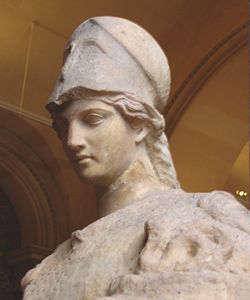
According to Apollodorus, Hephaestus attempted to rape Athena but was unsuccessful. His semen fell on the ground, and Erichthonius was born from the Earth, Gaia. Athena then raised the baby as a foster mother. Alternatively, the semen landed on Athena's leg, and she wiped it off with a piece of wool which she tossed on the ground. Erichthonius arose from the ground and the wool. Another version says that Hephaestus wanted Athena to marry him but she disappeared on his bridal bed; he ejaculated onto the ground instead. Athena left the baby to three sisters, Herse, Pandrosa and Aglaura in a small box and warned them never to open it. Aglaula opened the cista which contained the infant and future-king, Erichthonius, in the form of a serpent The sight caused Herse and Pandrosa to go insane and they threw themselves off the Acropolis'.
An alternative version of the same story is that while Athena was gone to bring a mountain to use in the Acropolis, two of the willful sisters opened the box. A crow witnessed the opening and flew away to tell Athena, who fell into a rage and dropped the mountain (now Mt. Lykabettos).[23] The crow was not spared from her wrath, and it is believed Athena was the one who turned their feathers black. Herse and Pandrosa once again went insane and threw themselves to their deaths off a cliff. Jane Harrison (Prolegomena) finds these to be versions of a simple cautionary tale to discourage young girls from opening the cista that they carried, not knowing its contents, in connection with the Thesmophoria.
Erichthonius later became King of Athens and implemented many beneficial changes to Athenian culture. During this time, Athena frequently protected him.
Aglaura
There is another version of the myth, told in Ovid's Metamorphoses in which Hermes falls in love with Herse. Herse, Aglaura and Pandrosa go to the temple to offer sacrifices to Athena. Hermes demands help from Aglaura to seduce Herse. Aglaura in exchange demands money from Hermes who gives her the money of sacrifice and seduces Herse.[24] Athena in punishment for Aglaura's greed asks the Envy to corrupt her feelings. Envy obeyed her commands and she infested Herse. Aglaura turns to stone.[25]
Athens
Athena competed with Poseidon to be the patron deity of Athens, which was yet unnamed in this telling. They agreed that each would give the Athenians one gift and that the Athenians would choose the gift they preferred. Poseidon struck the ground with his trident and a spring sprung up; this gave them a means of trade and water, but it was salty and not very good for drinking. Athena, however, offered them the first domesticated olive tree. The Athenians (or their king, Cecrops) accepted the olive tree and along with it Athena as their patron, for the olive tree brought wood, oil and food. This is thought to commemorate a clash between the inhabitants during Mycenaean times and newer immigrants. It is interesting to note that Athens at its height was a significant sea power, defeating the Persian fleet at the Battle of Salamis near Salamis Island in 480 B.C.E. Athena was also the patron goddess of several other cities, notably Sparta. In an alternate version, Poseidon invents the first horse. Athena's gift is still chosen.
Arachne
A woman named Arachne once boasted that she was a superior weaver to Athena, the goddess of weaving. Athena appeared to her disguised as an old woman and told Arachne to repent for her hubris but Arachne instead challenged Athena to a contest. Athena threw off her disguise and the contest began. Athena wove a depiction of the conflict with Poseidon over Athens, while Arachne wove a depiction making fun of Zeus and his many wives. Athena was furious at her skill (the contest was never decided) and her choice of subject (after all, she is Zeus's favorite daughter). Enraged, she destroyed Arachne's work. Arachne was so humilated by the contest that she hung herself. Athena felt sorry for what she had done and transformed Arachne into the first spider, which forever weaves a silk web to catch its food.[26]
Perseus and Medusa
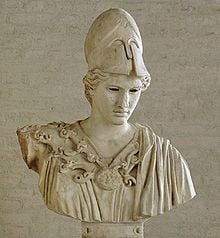
Athena guided Perseus in eliminating Medusa, a dangerous unreformed relic of the old pre-Olympian order, and she was awarded the grisly trophy that turned men to stone, for her shield.
She wears the aegis, a goatskin shield which had a fringe of snakes. When Perseus killed the gorgon Medusa, whose face turned men to stone, he gave the gorgon head to Athena, and the goddess placed it on her aegis. This is a protective measure, for the Medusa's head retained its petrifying power even after her death.
It was, however, Athena who made Medusa into what she was. Medusa was the only beautiful sister of the three Gorgons, but, Medusa had sex with — or was raped by — Poseidon in Athena's temple. Upon discovery of the desecration of her temple, Athena changed Medusa's form to match that of her sister Gorgons as punishment. Medusa's hair turned into snakes, meeting her gaze would turn all living creatures to stone, and Athena also caused her lower body to morph, as well as granting her the power of petrification as to hinder all chances of her ever having intimacy with a man.
Hercules
Athena instructed Hercules how to remove the skin from the Nemean Lion, by using the lion's own claws to cut through its thick hide. The lion's hide became Hercules' signature garment, along with the olive-wood club he used in the battle. Athena also assisted Hercules on a few other labors.
She also helped Hercules defeat the Stymphalian Birds, along with Hephaestus.
Tiresias and Chariclo
In one version of the Tiresias myth, Athena blinded Tiresias after he stumbled onto her bathing naked. His mother, Chariclo, begged her to undo her curse,[citation needed] but Athena could not do so; she gave him the ability of prophecy instead.[27]
Odysseus
Odysseus' cunning and shrewd nature quickly won Athena's favour, though she is largely confined to aiding him only from afar (implanting thoughts in his head) during his journey home from Troy. It is not until he washes up on the shore of an island where Nausicaa is washing her clothes that Athena can actually arrive herself to provide more tangible assistance. She appears in Nausicaa's dreams to ensure the princess rescues Odysseus and eventually sends him to Ithaca. Athena, herself, appears in disguise to Odysseus upon his arrival. She initially lies and tells him Penelope, his wife, has remarried and Odysseus is believed to be dead, though Odysseus lies to her, seeing through her disguise. Pleased with his resolve and shrewdness, she reveals herself to him and tells him everything he needed to know in order to win back his kingdom. She disguises him as an elderly man so that he will not be noticed by the Suitors or Penelope and she helps Odysseus defeat his suitors and end the feud against their relatives.
In post-classical culture
Athena (Minerva) is the subject of the $50 1915-S Panama-Pacific commemorative coin. At 2.5 troy oz (78 g) gold, this is the largest (by weight) coin ever produced by the U.S. Mint. This was the first $50 coin issued by the U.S. Mint and no higher was produced until the production of the $100 platinum coins in 1997. Of course, in terms of face-value in adjusted dollars, the 1915 is the highest denomination ever issued by the U.S. Mint.
For over a century full-scale replica of the Parthenon has stood in Nashville, Tennessee, which is known as the Athens of the South. In 1990, a gilded 41 foot (12.5 m) tall replica of Phidias' statue of the goddess was added.
The state seal of California features an image of Athena (or Minerva) kneeling next to a brown grizzly bear.[3]
She is the symbol of the Darmstadt University of Technology, Germany.
The name Athena is used by two characters in both the original Battlestar Galactica and the reimagined science fiction series.
Athena is a main character in the Masami Kurumada's manga Saint Seiya.
In the video game series God of War Athena was the god's messenger to the warrior Kratos and guided him through his quest to destroy Ares. In God of War II She tries to warn him that Gaia is only using him and shouldn't side with the Titans.Kratos accidently slayed Athena when she threw herself in front his blade of Olympus to protect Zeus and tells Kratos he is Zeus' abandoned offspring and her half brother.
In the Matrix Remake Play Athena is the mother of Neo but later disowns him for his unnatural birth. She is shown teaching Neo bulletstop and lightning vision during his childhood. Although she acts like she still hates Neo, she still shows maternal affection at times. Athena finds it amusing that Neo tries to regain his mother's favor.
Athena is portrayed as a prominent character in DC Comics' Wonder Woman series. She is shown to later surpass Zeus as leader of the Greek Gods.
Athena's Helmet is the central feature on the United States Military Academy crest.
Athena is source of influence for feminist theologians such as Carol P. Christ.
Notes
- ↑ Zeus is also "Aegis-bearing Zeus".
- ↑ "Whether the goddess was named after the city or the city after the goddess is an ancient dispute" (Burkert, p. 139).
- ↑ Ruck and Staples, p. 24.
- ↑ Whether her name is attested in Eteocretan or not will have to wait for decipherment of Linear A.
- ↑ Frederick John Kluth, "The Role of Athena in Ancient Greek Art"
- ↑ Compare the prophecy concerning Thetis.
- ↑ G. Neumann, [article title missing] Kadmos 6 (1967).
- ↑ Kn V 52 (text 208 in Ventris and Chadwick).
- ↑ Palaima, p. 444.
- ↑ Burkert, p. 44.
- ↑ Ventris and Chadwick [page missing]
- ↑ "That is a graver matter, and there, my friend, the modern interpreters of Homer may, I think, assist in explaining the view of the ancients. For most of these in their explanations of the poet, assert that he meant by Athene "mind" (nous) and "intelligence" (dianoia), and the maker of names appears to have had a singular notion about her; and indeed calls her by a still higher title, "divine intelligence" (Thou noesis), as though he would say: This is she who has the mind of God (Theonoa);- using a as a dialectical variety e, and taking away i and s. Perhaps, however, the name Theonoe may mean "she who knows divine things" (Theia noousa) better than others. Nor shall we be far wrong in supposing that the author of it wished to identify this Goddess with moral intelligence (en ethei noesin), and therefore gave her the name ethonoe; which, however, either he or his successors have altered into what they thought a nicer form, and called her Athene". (Cratylus 407b).
- ↑ "The citizens have a deity for their foundress; she is called in the Egyptian tongue Neith, and is asserted by them to be the same whom the Hellenes call Athene; they are great lovers of the Athenians, and say that they are in some way related to them". ( Timaeus 21e)
- ↑ Henry George Liddell, Robert Scott, 1940, A Greek-English Lexicon, ISBN 0-19-864226-1, online version at the Perseus Project
- ↑ Karl Kerenyi suggests that "Tritogeneia did not mean that she came into the world on any particular river or lake, but that she was born of the water itself; for the name Triton seems to be associated with water generally." (Kerenyi, p. 128).
- ↑ Graves, p. 51.
- ↑ Burkert, p. 139.
- ↑ The story comes from Libyan (modern Berbers) where the Greek Athena and the Egyptian Neith blend in to one god. The story is not so often referenced because some facts contradict other more well documented facts. Frazer, vol. 2 p.41
- ↑ [1]
- ↑ [2]
- ↑ Burkert, p. 140.
- ↑ Graves, Robert, The Greek Myths I, "The Birth of Athena," 8.a.
- ↑ Graves, Robert, The Greek Myths I, "The Nature and Deeds of Athena" 25.d.
- ↑ Ovid, Metamorphoses, X. Aglaura, Book II, 708-751.
- ↑ Ovid, Metamorphoses, XI. The Envy. Aglaura as result of this, turns to a statue, Book II, 752-832.
- ↑ Ovid, Metamorphoses,I. Pallas and Arachne, Book VI, 1-145; the sentiment inherent in Ovid's narrative and its ascription of human emotions, reveal its late date in this version.
- ↑ Graves, Robert, The Greek Myths I,"The Nature and Deeds of Athena" 25.g.
Bibliography
- Burkert, Walter, 1985. Greek Religion (Harvard).
- Graves, Robert, (1955) 1960. The Greek Myths revised edition.
- Harrison, Jane Ellen, 1903. Prolegomena to the Study of Greek Religion.
- Kerenyi, Karl, 1951. The Gods of the Greeks (Thames and Hudson).
- Palaima, Thomas, 2004. "Appendix One: Linear B Sources." In Trzaskoma, Stephen, et al., eds., Anthology of Classical Myth: Primary Sources in Translation (Hackett).
- Ruck, Carl A.P. and Danny Staples, 1994. The World of Classical Myth: Gods and Goddesses, Heroines and Heroes (Durham, NC).
- Telenius, Seppo Sakari, 2005 and 2006. Athena-Artemis.
- Ventris, Michael and John Chadwick, 1973. Documents in Mycenaean Greek (Cambridge).
External links
- (Carlos Parada) Athena Album Repertory of main Athena types and post-Renaissance depictions
- Roy George, "Athena: The sculptures of the goddess": Another, more extensive repertory of Greek and Roman types
- Theoi.com Cult of Athena Extracts of classical texts
- Nashville's Athena statue
- The Nashville Parthenon
- Minoan Origins of Athena by Virginia Hicks
- Athena - "The Statue of Freedom" atop the US Capitol building
Credits
New World Encyclopedia writers and editors rewrote and completed the Wikipedia article in accordance with New World Encyclopedia standards. This article abides by terms of the Creative Commons CC-by-sa 3.0 License (CC-by-sa), which may be used and disseminated with proper attribution. Credit is due under the terms of this license that can reference both the New World Encyclopedia contributors and the selfless volunteer contributors of the Wikimedia Foundation. To cite this article click here for a list of acceptable citing formats.The history of earlier contributions by wikipedians is accessible to researchers here:
The history of this article since it was imported to New World Encyclopedia:
Note: Some restrictions may apply to use of individual images which are separately licensed.
